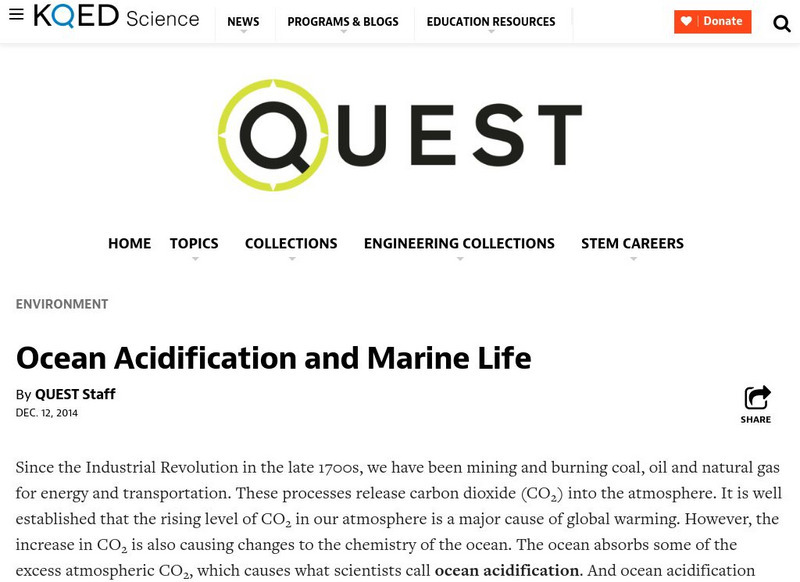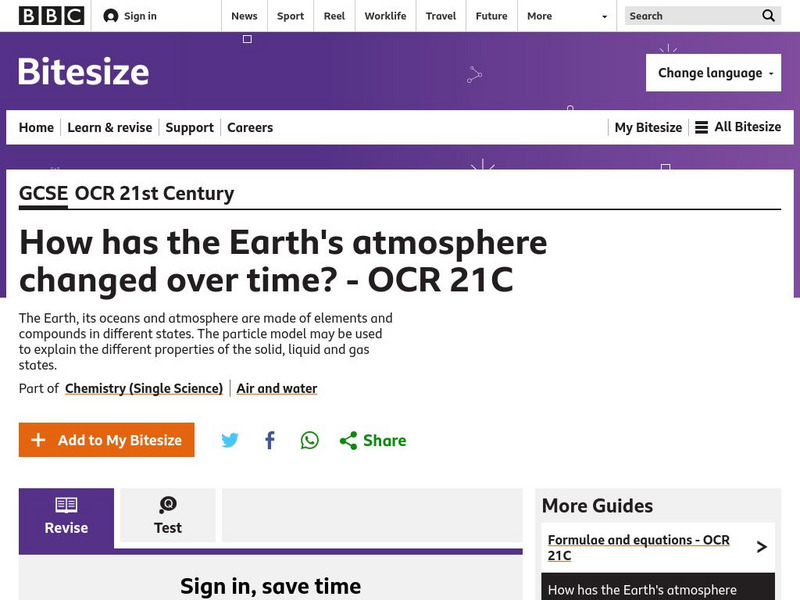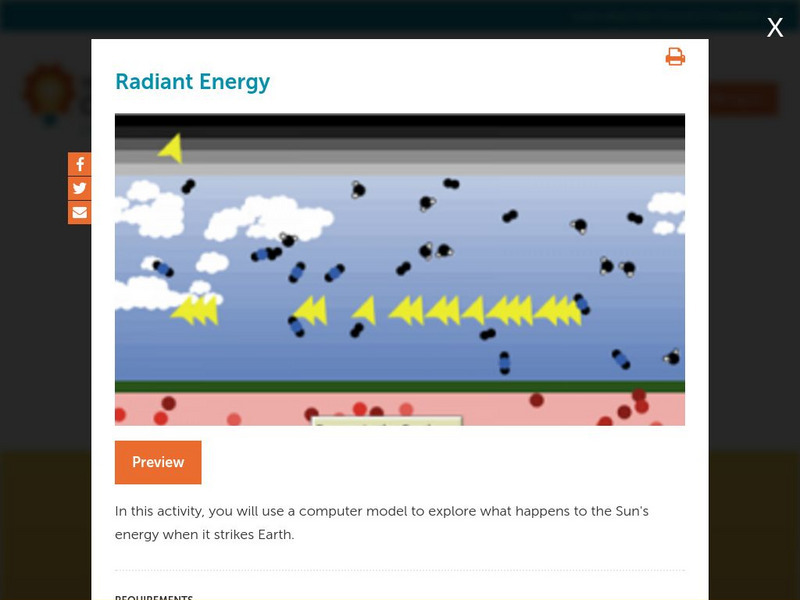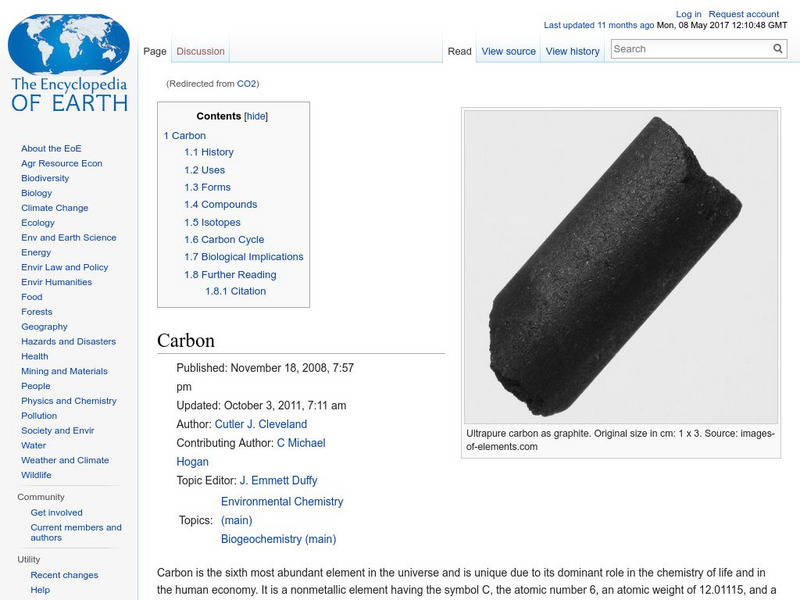PBS
Quest: How Ocean Acidification Affects Shelled Organisms
This step-by-step tutorial walks students through the effects of ocean acidification on some shelled marine organisms.
Other
Elmhurst College: Virtual Chembook: Carbon Cycle
A step-by-step discussion of the stages in the carbon cycle. Each step includes a diagram further explaining the processes involved, as well as pictures depicting combustion, respiration, photosynthesis, and decomposition.
Other
Rocky Mountain Institute: Climate Protection for Fun & Profit [Pdf]
The first article in this newsletter talks about a speech made by Former President Bill Clinton and his stance on the environment. (Published 1997)
Chem Tutor
Chem Tutor: Dissolving Gases Into Liquids
Description of the factors influencing gas solubility. This site also provides other chemistry related questions. Topics include dissolving solids into liquids, concentration, and stoichiometry.
Enchanted Learning
Enchanted Learning: Label the Lungs
Do you know the parts of the lung? Check out this lung diagram that can be printed out for students to label the various parts.
American Geosciences Institute
American Geosciences Institute: Earth Science Week: Chemistry of Burning
In this activity, students use pipe cleaners and foam balls to build a model of a hydrocarbon molecule. They then modify it to demonstrate the chemical reaction that happens when the hydrocarbon is burned.
PBS
Nova: The Big Energy Gamble
Students conduct an energy audit to determine how much carbon dioxide their family is producing, and then make recommendations for lowering their family's carbon footprint.
Concord Consortium
Concord Consortium: Stem Resources: Greenhouse Gases
Do you understand the relationship between temperature and carbon dioxide in our atmosphere? This computer model shows factors such as clouds and carbon dioxide that could cause global temperatures to rise. Students investigate how the...
American Geosciences Institute
American Geosciences Institute: Earth Science Week: Your Own Greenhouse
Climate scientists around the world study greenhouse gases and the ways they affect global climate. By making a small greenhouse, recreate the greenhouse effect and measure its effect on temperature.
BBC
Bbc: Gcse Bitesize: How Has the Earth's Atmosphere Changed Over Time? Ocr 21 C
This lesson focuses on ways to reduce air pollution from power stations and from automobiles. It provides a link to an assessment.
Concord Consortium
Concord Consortium: Stem Resources: Radiant Energy Flow
A virtual lab to look at the physical features of Earth that affect the amount of the Sun's energy that hits Earth. Students investigate how solar and infrared radiations enters and leaves the atmosphere with this model. Virtual lab...
Encyclopedia of Earth
Encyclopedia of Earth: Physics & Chemistry: Carbon Dioxide
Explains what carbon dioxide is, where it is found, sources of it, and describes human activities that contribute to carbon depletion and increased levels of carbon dioxide in the atmosphere. (Updated: February 22, 2013)
University Corporation for Atmospheric Research
Ucar: The Greenhouse Effect
Students will learn how greenhouse gases temporarily trap heat within Earth's atmosphere, warming the planet via the greenhouse effect.
North Central Regional Educational Laboratory
Kids Learn: Respiratory System Internet Workshop
Come and explore this internet workshop that was designed to introduce you to a study on the respiratory system. Students and teachers will benefit from this resource.
University Corporation for Atmospheric Research
Ucar: Learn: The Greenhouse Effect
A detailed overview of the greenhouse effect, with explanations about Earth's atmosphere gases referred to as greenhouse gases, and the factors that influence the heat-trapping ability of a greenhouse. All information is reinforced...
University Corporation for Atmospheric Research
Ucar: What Do Soda and the Oceans Have in Common?
Learners will use soda to explore how carbon dioxide is able to dissolve into liquid. They will learn about Henry's law, which describes how the solubility of gas into liquids is dependent on temperature and develop hypotheses about how...
University Corporation for Atmospheric Research
Ucar: Co2: How Much Do You Spew?
Learners analyze the energy consumption of a hypothetical household to determine the amount of carbon dioxide they are adding to the atmosphere each year.
University Corporation for Atmospheric Research
Ucar: Climate Sensitivity Calculator
This simple calculator allows you to play around with the relationship between atmospheric CO2 concentration and average global temperatures. This is called climate sensitivity.
Energy4Me
Energy4me: Carbon Footprint
After completing the first part of this activity, students will be able to explain individual carbon footprints and list the means for reducing them. The second part of this activity helps students to visualize climate as a system with...
University Corporation for Atmospheric Research
Ucar: Carbon Dioxide
Learn all about Carbon Dioxide, an important constituent of our planet's air playing an important role in Earth's carbon cycle and photosynthesis.
University Corporation for Atmospheric Research
Ucar: The Carbon Cycle
A comprehensive introduction to the carbon cycle. The cycle of atoms between living and non-living things is known as a biogeochemical cycle. The most common of these are the carbon and nitrogen cycles.
National Earth Science Teachers Association
Windows to the Universe: Biogeochemical Cycles
Biogeochemical cycles happen when individual elements are recycled over and over in different parts of the Earth. Two examples are the Nitrogen Cycle and Carbon Cycle. Read an explanation of biogeochemical cycles and view a diagram of...
PBS
Pbs Learning Media: Understanding Air: Climate Change and Modeling Combustion
For this lesson, students learn about the components of air and the chemical reactions that release carbon dioxide into the atmosphere and explore the connection between carbon dioxide, climate change, and environmental health.
Utah Education Network
Uen: Co2 in Car Exhaust
Learners will investigate the carbon dioxide content in different types of cars.




![Rocky Mountain Institute: Climate Protection for Fun & Profit [Pdf] Article Rocky Mountain Institute: Climate Protection for Fun & Profit [Pdf] Article](https://d15y2dacu3jp90.cloudfront.net/images/attachment_defaults/resource/large/FPO-knovation.png)










